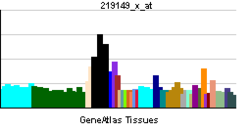- DBR1
-
This article is about a human gene. For the automobile, see Aston Martin DBR1.
Debranching enzyme homolog 1 (S. cerevisiae) Identifiers Symbols DBR1; External IDs OMIM: 607024 MGI: 1931520 HomoloGene: 9428 GeneCards: DBR1 Gene Gene Ontology Molecular function • RNA lariat debranching enzyme activity
• hydrolase activity, acting on ester bonds
• metal ion bindingCellular component • nucleus Biological process • RNA splicing, via transesterification reactions
• nuclear mRNA splicing, via spliceosomeSources: Amigo / QuickGO RNA expression pattern 
More reference expression data Orthologs Species Human Mouse Entrez 51163 83703 Ensembl ENSG00000138231 ENSMUSG00000032469 UniProt Q9UK59 Q8BP51 RefSeq (mRNA) NM_016216 NM_031403.3 RefSeq (protein) NP_057300 NP_113580.2 Location (UCSC) Chr 3:
137.88 – 137.89 MbChr 9:
99.48 – 99.48 MbPubMed search [1] [2] Lariat debranching enzyme is a protein that in humans is encoded by the DBR1 gene.[1][2]
The RNA lariat debranching enzyme, or DBR1, specifically hydrolyzes 2-prime-to-5-prime branched phosphodiester bonds at the branch point of excised lariat intron RNA and converts them into linear molecules.[supplied by OMIM][2]
References
- ^ Kim JW, Kim HC, Kim GM, Yang JM, Boeke JD, Nam K (Sep 2000). "Human RNA lariat debranching enzyme cDNA complements the phenotypes of Saccharomyces cerevisiae dbr1 and Schizosaccharomyces pombe dbr1 mutants". Nucleic Acids Res 28 (18): 3666–73. doi:10.1093/nar/28.18.3666. PMC 110720. PMID 10982890. http://www.pubmedcentral.nih.gov/articlerender.fcgi?tool=pmcentrez&artid=110720.
- ^ a b "Entrez Gene: DBR1 debranching enzyme homolog 1 (S. cerevisiae)". http://www.ncbi.nlm.nih.gov/sites/entrez?Db=gene&Cmd=ShowDetailView&TermToSearch=51163.
Further reading
- Chapman KB, Boeke JD (1991). "Isolation and characterization of the gene encoding yeast debranching enzyme.". Cell 65 (3): 483–92. doi:10.1016/0092-8674(91)90466-C. PMID 1850323.
- Arenas J, Hurwitz J (1987). "Purification of a RNA debranching activity from HeLa cells.". J. Biol. Chem. 262 (9): 4274–9. PMID 2435736.
- Martin A, Schneider S, Schwer B (2002). "Prp43 is an essential RNA-dependent ATPase required for release of lariat-intron from the spliceosome.". J. Biol. Chem. 277 (20): 17743–50. doi:10.1074/jbc.M200762200. PMID 11886864.
- Strausberg RL, Feingold EA, Grouse LH, et al. (2003). "Generation and initial analysis of more than 15,000 full-length human and mouse cDNA sequences.". Proc. Natl. Acad. Sci. U.S.A. 99 (26): 16899–903. doi:10.1073/pnas.242603899. PMC 139241. PMID 12477932. http://www.pubmedcentral.nih.gov/articlerender.fcgi?tool=pmcentrez&artid=139241.
- Ota T, Suzuki Y, Nishikawa T, et al. (2004). "Complete sequencing and characterization of 21,243 full-length human cDNAs.". Nat. Genet. 36 (1): 40–5. doi:10.1038/ng1285. PMID 14702039.
- Gerhard DS, Wagner L, Feingold EA, et al. (2004). "The status, quality, and expansion of the NIH full-length cDNA project: the Mammalian Gene Collection (MGC).". Genome Res. 14 (10B): 2121–7. doi:10.1101/gr.2596504. PMC 528928. PMID 15489334. http://www.pubmedcentral.nih.gov/articlerender.fcgi?tool=pmcentrez&artid=528928.
- Ye Y, De Leon J, Yokoyama N, et al. (2006). "DBR1 siRNA inhibition of HIV-1 replication.". Retrovirology 2: 63. doi:10.1186/1742-4690-2-63. PMC 1266399. PMID 16232320. http://www.pubmedcentral.nih.gov/articlerender.fcgi?tool=pmcentrez&artid=1266399.
- Olsen JV, Blagoev B, Gnad F, et al. (2006). "Global, in vivo, and site-specific phosphorylation dynamics in signaling networks.". Cell 127 (3): 635–48. doi:10.1016/j.cell.2006.09.026. PMID 17081983.
Categories:- Human proteins
- Chromosome 3 gene stubs
Wikimedia Foundation. 2010.
